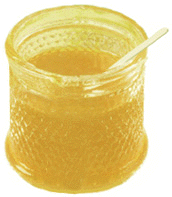...Best of Sicily presents... Best of Sicily Magazine. ... Dedicated to Sicilian art, culture, history, people, places and all things Sicilian. |
by Roberta Gangi | ||
Magazine Index Best of Sicily Arts & Culture Fashion Food & Wine History & Society About Us Travel Faqs Contact Map of Sicily |
Citrus fruits were known to the Romans, whose empire encompassed citrus-growing regions in Egypt and Persia, but it was the North African Arabs who introduced the widespread cultivation of lemons and oranges in Sicily in the ninth century. This profoundly influenced the composition of the nectar from which most Sicilian honey is made, for its flavour is a direct result of that of the bees' source. But the Arabs introduced another crop, one which was to attenuate the importance of honey as a sweetener. This was sugar cane. Like cotton (also introduced in Sicily by the Saracens), sugar cane is no longer raised in Sicily, yet the use of cane sugar in sweets completely changed the face of medieval Sicilian cuisine. It meant that the tasty frostings, candied fruits and cheese filling of cassata, and the creamy filling of cannoli, preparations attributed to the Sicilian Arabs, could be made with granular cane sugar. Sugar was sometimes used, as an alternative to drying, to preserve fruts. Ice cream had existed in Sicily at least since Roman times but it too would now be prepared with cane sugar. Indeed, Sicilian honey production decreased drastically following the introduction of cane sugar. By the thirteenth century, it was no longer considered an important product and beekeepers were few. This explains why so few existing Sicilian recipes call for honey as an essential ingredient. Sicilian cuisine is not unique in this regard. The increasingly widespread use of cane sugar reduced honey's importance in many parts of the world, forcing local cuisines to evolve in unexpected ways. Most the Sicilian confections enjoyed today were handed down to us by the Arabs who ruled the island for three centuries until the Normans arrived in the 1060s. There has been a slight resurgence of honey production in Sicily in recent years. Quantities are small but quality is high. "Varietal" honey (made from one kind of flower) seems to be the current rage, and Sicilian Orange Blossom is the perfect flavour. About the Author: Roberta Gangi has written numerous articles and one book dealing with Italian cultural and culinary history, and several food and wine articles for Best of Sicily Magazine. | |
Top of Page |
 Honey, known to the most ancient civilisations, has been produced in Sicily for thousands of years, but its flavour has changed over the centuries. This is not to suggest that the bees (the productive "Italian" variety Apis Mellifera Ligustica known the world over) have changed their methods. It's the flowers that have changed. In antiquity, wild flowers were the main source of nectar in Sicily, and in most other regions. The honey known in Italy as millefiori ("thousands of flowers") reflects this ancient heritage. Today, however, most Sicilian honey is made from orange blossom nectar or even eucalyptus nectar. Less often, the honey produced in Sicily is made from the blossoms of almonds and other trees. Bees are important for pollination; fruit production would be less were it not for the honeybee.
Honey, known to the most ancient civilisations, has been produced in Sicily for thousands of years, but its flavour has changed over the centuries. This is not to suggest that the bees (the productive "Italian" variety Apis Mellifera Ligustica known the world over) have changed their methods. It's the flowers that have changed. In antiquity, wild flowers were the main source of nectar in Sicily, and in most other regions. The honey known in Italy as millefiori ("thousands of flowers") reflects this ancient heritage. Today, however, most Sicilian honey is made from orange blossom nectar or even eucalyptus nectar. Less often, the honey produced in Sicily is made from the blossoms of almonds and other trees. Bees are important for pollination; fruit production would be less were it not for the honeybee.